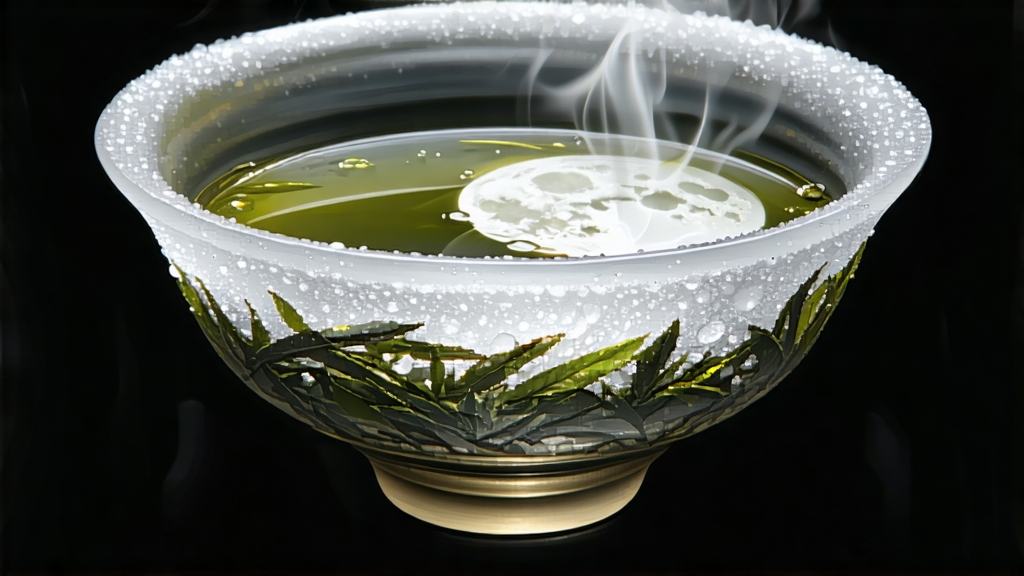
Tucked high on the forested ridges of Yunnan’s Simao region, where the Mekong carves silver ribbons through subtropical clouds, a tea is picked that never sees the sun. Local tea farmers call it Yue Guang Bai—Moonlight White—because every step of its brief life is governed by lunar rhythms. While most white teas surrender their green freshness to gentle daylight withering, Yue Guang Bai is plucked, spread and dried entirely between dusk and dawn, absorbing cool mountain vapors and the resinous perfume of night-blooming orchids. The result is a leaf half-silver, half-ink, that brews a liquor the color of pale chardonnay and tastes like honey still clinging to the comb. For international drinkers who know only the feather-soft Chinese silver-needle or the nutty Shou Mei, Yue Guang Bai offers a darker, more sensuous face of white tea—one that carries the terroir of ancient camellia forests and the hush of moonlit courtyards.
1. Historical hush: how a secret became a style
White tea as a category was first recorded in Song-dynasty treatises, yet Yue Guang Bai is barely thirty years old. During the early 1990s, growers in Yunnan—accustomed to producing sun-dried pu-erh maocha—experimented with white-tea techniques to meet coastal demand for minimally processed leaves. One small cooperative in Jinggu County decided to wither their buds and leaves on raised bamboo trays inside an open-walled pavilion, taking advantage of Yunnan’s low night humidity. A freak week of cloudy weather forced them to extend withering past sunrise; when they finally tasted the tea, they found a deeper, malt-sweet cup unlike any white tea they knew. Word spread, and moonlight withering became a deliberate protocol rather than an accident. Because the method demanded cool air and low ultraviolet exposure, production was limited to the lunar phases around the full moon, giving the tea its romantic name and an air of exclusivity that still defines it today.
2. Botanical birthright: big-leaf white tea
Unlike Fujian’s white teas, which use the small-leaf Da Bai cultivar, Yue Guang Bai is crafted from Yunnan’s indigenous Da Ye Zhong (broad-leaf) assamica. The leaves are thicker, more pectin-rich, and shot through with golden buds the size of a fingernail. These buds contain up to 5.5 % L-theanine, almost double that of conventional white tips, explaining the tea’s syrupy mouthfeel and lingering sweet finish. Farmers harvest only one bud and the adjacent half-open leaf, a pluck standard known locally as “one spear, one flag.” Because the assamica plant flushes year-round in Yunnan’s mild climate, spring, summer and autumn pickings are possible, yet connoisseurs prize the March harvest for its balance of amino acids and aromatic volatiles.
3. Crafting by moonlight: the invisible choreography
Processing begins at 7 p.m., when UV index drops below three. Workers carry shallow bamboo trays into the tea garden, pluck directly into them, and immediately retreat to the withering loft—an elevated, mosquito-netted corridor open to cross-breezes but shielded from starlight by black gauze. For the next eight hours the leaves rest in darkness, losing moisture slowly while oxidative enzymes nibble at the edges, turning the upper surface of each leaf a charcoal black and leaving the underside silvery down. Around 3 a.m., when humidity peaks, the tea master judges the “soft waist” moment: leaves must feel like softened leather yet retain a spine of resilience. A quick five-minute tumble in a ventilated drum halts enzymatic browning, after which the tea is transferred to low-temperature dryers set at 35 °C—just warm enough to finish the job before sunrise. The entire cycle is completed by 5:30 a.m., locking in a fragrance that oscillates between fresh-cut hay and dark molasses.
4. Grades and guises: from Needle to Cake
Although Yue Guang Bai is sometimes sold as loose leaf, Yunnan producers also compress it into 100 g mini cakes using light stone presses. The three recognized grades are:
- Yue Ya (Moon Bud): 100 % buds, charcoal on top, silver below; brews a champagne-colored cup with notes of vanilla orchid.
- **